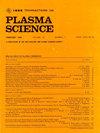Simulation Study on Ellipsoidal Electrode Negative Corona Discharge in Ring Mode
IF 1.5
4区 物理与天体物理
Q3 PHYSICS, FLUIDS & PLASMAS
引用次数: 0
Abstract
The corona discharge phenomenon has been of great interest, and it is widely used in practical applications. By coupling the fluid dynamics equations and the Poisson equation, the negative corona discharge between椭圆电极环模式负电晕放电的仿真研究
电晕放电现象引起了人们极大的兴趣,并在实际应用中得到了广泛的应用。结合流体力学方程和泊松方程,建立了平面与椭球电极负电晕放电的数学模型。本文首次通过数值模拟系统地研究了环形放电的机理。分析了不同阴极形状、外加电压和间隙距离等电极平面设置条件与首次放电模式的关系。环形模式放电发生的位置与放电过程中的最大电场强度有关,而最大电场强度是由畴内边界电荷和体积电荷共同作用产生的。研究发现,在某些情况下,放电脉冲可以全部处于环形模式。当外加电压绝对值较低、半轴比$a/b$较大或间隙距离较长时,第一次放电倾向于环形模式。该研究为静电除尘器、等离子体装置、航空发动机和其他利用电晕放电的装置的电极优化设计和提高放电效率提供了重要的见解。
本文章由计算机程序翻译,如有差异,请以英文原文为准。
求助全文
约1分钟内获得全文
求助全文
来源期刊

IEEE Transactions on Plasma Science
物理-物理:流体与等离子体
CiteScore
3.00
自引率
20.00%
发文量
538
审稿时长
3.8 months
期刊介绍:
The scope covers all aspects of the theory and application of plasma science. It includes the following areas: magnetohydrodynamics; thermionics and plasma diodes; basic plasma phenomena; gaseous electronics; microwave/plasma interaction; electron, ion, and plasma sources; space plasmas; intense electron and ion beams; laser-plasma interactions; plasma diagnostics; plasma chemistry and processing; solid-state plasmas; plasma heating; plasma for controlled fusion research; high energy density plasmas; industrial/commercial applications of plasma physics; plasma waves and instabilities; and high power microwave and submillimeter wave generation.
 求助内容:
求助内容: 应助结果提醒方式:
应助结果提醒方式:


